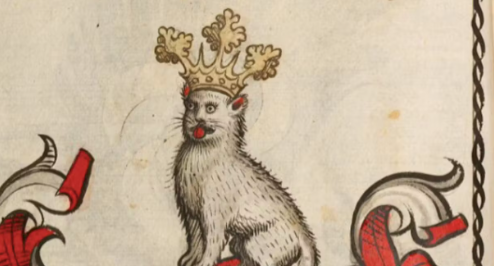The Middle Ages, a period often romanticized for its knights, damsels, and grand castles, also holds a unique charm for its enigmatic relationship with our furry companions – cats. While these independent creatures patrolled the halls and stalked the rodents of medieval Europe, their presence remains shrouded in a veil of mystery, particularly when it comes to their names. Unlike their canine counterparts, documented medieval cat names are scarce, leaving us to piece together this puzzle through historical fragments, folklore, and a dash of educated guesswork. This article delves into the fascinating world of medieval cat names, exploring their origins, meanings, and the cultural context that shaped them.

A World of Whiskers and Whimsey: Approaches to Medieval Cat Naming
Unlike modern pet owners who meticulously select names overflowing with personality and pop culture references, medieval cat naming appears to have been a more practical affair. Here, we explore the various approaches people might have taken:
- Descriptive Names: Medieval life was grounded in practicality, and this extended to pet names. Cats were likely given names that reflected their physical attributes, such as “Blackie,” “Whiskers,” or “Patch” for a feline with distinctive markings. Similarly, a particularly large cat might be called “Sturdy” or a curious one “Nosewise.”
- Functional Names: In a time where cats were valued for their rodent-hunting prowess, names might have alluded to this function. “Mouser” or “Hunter” are clear examples, while names like “Clawdia” (a playful twist on “Claudia”) or “Scratch” might hint at a cat’s less cuddly side.
- Human Names: Interestingly, some cats were given human names, often shortened versions. In England, “Gyb” – a shortened form of Gilbert – was a popular generic term for cats, and it’s likely individual cats were also named “Gilbert” or “Gibbons.” Similarly, French felines might be called “Tibert” or “Tibbaud,” derived from “Theobald.”
- Folklore and Superstition: Medieval society was steeped in folklore and superstition. Cats, with their nocturnal habits and independent spirit, were often seen as creatures with mystical connections. This might have led to names inspired by mythology or cautionary tales, such as “Familiar” (referencing a witch’s companion) or “Shadow” (evoking a cat’s association with darkness).
Beyond the Name: A Glimpse into the Medieval Human-Cat Bond
While documented names are scarce, historical accounts and artistic depictions offer glimpses into the evolving relationship between humans and cats during the Middle Ages. Here are some intriguing insights:
- Working Partners: Cats were primarily valued for their pest control abilities. Monasteries, with their abundance of stored grains and manuscripts, often kept large numbers of cats. These felines were likely well-cared for, even receiving special rations in some cases.
- Shifting Perceptions: Early medieval attitudes towards cats were likely ambivalent. While their practical value was undeniable, associations with pagan beliefs and witchcraft sometimes cast a shadow over these creatures. However, by the later Middle Ages, cats became more accepted household companions, especially among the wealthier classes.
- Artistic Inspiration: Cats began to appear in medieval illuminated manuscripts and marginalia. These depictions, while often whimsical and humorous, offer valuable insights into how people viewed and interacted with their feline companions.
Possible Origins of Medieval Cat Names
| Category | Possible Name | Meaning/Origin |
|---|---|---|
| Descriptive | Blackie | Refers to the cat’s fur color |
| Descriptive | Whiskers | Refers to a prominent physical feature |
| Functional | Mouser | Highlights the cat’s hunting skills |
| Human Name (Shortened) | Gyb | Shortened form of Gilbert |
| Folklore/Superstition | Familiar | Refers to a witch’s cat companion |
Unraveling the Tapestry: Researching Medieval Cat Names
Unfortunately, unlike dog breeds with documented lineages, there’s no central registry for medieval cat names. However, researchers can piece together this puzzle through various sources:
- Medieval Literature: While direct references to pet cat names are rare, medieval literature sometimes mentions cats with descriptive terms. For example, Geoffrey Chaucer’s “The Canterbury Tales” features a nun who keeps a series of white cats named “Smalkin,” “Tibbald,” and “Spette.” While these might be fictional names, they offer valuable clues about the types of names people might have used for their feline companions.
- Household Accounts: Occasionally, household accounts from wealthy estates mention expenditures related to cat care. These records might include the purchase of food or mention a specific cat by name, providing a rare glimpse into individual cat names.
- Marginalia and Illustrations: Medieval manuscripts often contain marginal illustrations depicting everyday life, including cats. While these drawings might not always identify the cats by name, they can offer clues about how cats were integrated into medieval homes and the roles they played.
A Tapestry of Tongues: The Multilingual World of Medieval Cats
Europe during the Middle Ages was a linguistically diverse region. This diversity is reflected in the potential names given to cats. Here’s a look at some possibilities:
- Latin: As the language of the Church and scholarship, Latin might have been used to name cats, particularly those belonging to monasteries or the clergy. Names like “Felis” (meaning “cat”) or “Muris” (meaning “mouse”) are possibilities.
- French: In France, cats were often called “Tibaut” or “Tibert,” derived from “Theobald.” Other French names might include descriptive terms like “Chat Noir” (Black Cat).
- German: German cat names might have been descriptive like “Schwarz” (Black) or “Grau” (Gray), or could have drawn on Germanic mythology, such as names referencing Freyja, the Norse goddess associated with cats.
The Enduring Allure: Medieval Cat Names in the Modern World
While the exact names used by medieval people remain a mystery, the essence of their relationship with cats resonates even today. The practicality of medieval cat naming mirrors our own desire for descriptive and functional names. The intrigue surrounding folkloric names inspires us to choose names with mythological or literary connections. Ultimately, the scarcity of documented medieval cat names only enhances their mystique and fuels our curiosity about these fascinating feline companions of a bygone era.
Conclusion
The world of medieval cat names remains shrouded in some mystery, yet the fragments of evidence we possess paint a compelling picture. From descriptive names reflecting appearance and function to names tinged with folklore and superstition, these names offer a glimpse into the evolving relationship between humans and cats during the Middle Ages. As we continue to unravel the tapestry of medieval life, the enigma of medieval cat names only adds to the richness and complexity of this historical period.
Additional Resources for Delving Deeper into Medieval Cat Names
The world of medieval cat names is a fascinating but challenging research area. Here are some additional resources to help you delve deeper:
Online Resources:
- The Medieval Household: This website by The National Archives UK explores various aspects of daily life in the Middle Ages, including pets. While there might not be a dedicated section on cat names, browsing through household accounts or other resources might reveal interesting tidbits (https://www.nationalarchives.gov.uk/help-with-your-research/research-guides/medieval-political-history/).
- The Society for Medieval Studies: This organization offers a wealth of resources on medieval history, including online publications and conference proceedings. Searching their database with keywords like “cats,” “pets,” or “household accounts” might lead you to unexpected discoveries (https://mvstconference.ace.fordham.edu/).
- The British Library: The British Library’s digitized manuscript collection offers a treasure trove of medieval texts. While searching for explicit references to cat names might be challenging, exploring illuminated manuscripts with depictions of cats could offer clues about their integration into everyday life (https://www.bl.uk/).
Books and Articles:
- Animals and Society in Medieval Europe by Frances Gies- This book explores the role of animals in medieval society, including cats. While the focus might not be solely on names, it might provide valuable context for understanding the human-cat bond during this period.
- The Codex Ashburnham 1166: This 13th-century manuscript from England contains various texts, including a household account with a possible reference to a cat named “Rose.” While a single example, it highlights the potential for uncovering cat names within historical documents.
- Medieval Pets by Kathleen Walker-Meikle: This book delves into the fascinating world of medieval pets, including a chapter dedicated to cats. It explores historical references to cats, including potential names and nicknames.
Museum Collections:
- The Metropolitan Museum of Art’s Cloisters Collection: Located in New York City, the Cloisters Collection houses medieval art and artifacts, including illuminated manuscripts. While not guaranteed, some manuscripts might depict cats, offering a glimpse into their place in medieval society.
- The British Museum: The British Museum’s vast collection includes artifacts from across the medieval world. Exploring their online database or visiting the museum in person might reveal interesting depictions of cats that could shed light on their relationship with humans.
Remember, the scarcity of documented medieval cat names makes the research process both challenging and rewarding. By combining these resources with a dash of creativity and historical context, you can embark on your own adventure to unravel the mystery of these feline enigmas.






